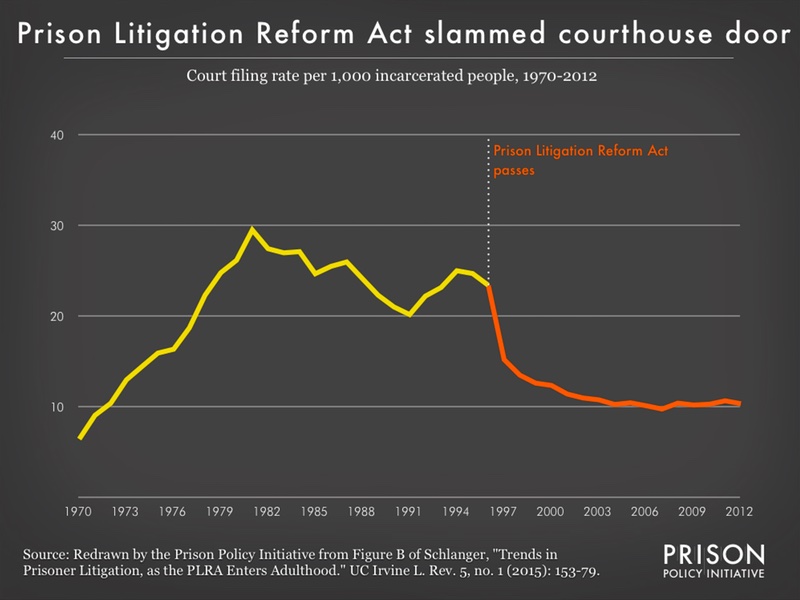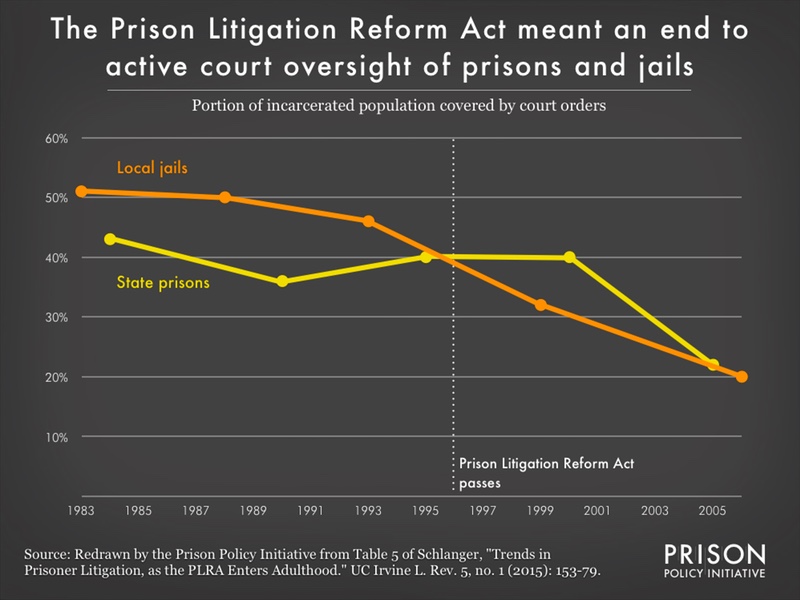20 years is enough: Time to repeal the Prison Litigation Reform Act
Professor Margo Schlanger's data shows how the Prison Litigation Reform Act closed the courthouse door on incarcerated people seeking protection of their civil rights.
by Meredith Booker, May 5, 2016
This article was updated in 2021 in a major report with more recent data about the impact of the Prison Litigation Reform Act. That version should be used instead of this one.
The Prison Litigation Reform Act, which made it much harder for incarcerated people to file and win civil rights lawsuits in federal court, was a key part of the Clinton-era prison boom. It turned 20 years old last week.
Law Professor Margo Schlanger has an important article using 40 years of court and imprisonment data to explore the impact of the Prison Litigation Reform Act on incarcerated people’s access to the courts:

The filing rate by incarcerated people dropped significantly after the passage of the Prison Litigation Reform Act. And ironically, despite Congress’ fears of a prison lawsuits flooding the courts, this data that controls for the size of the prison population shows that in 1996, when the Prison Litigation Reform Act was passed, fewer lawsuits per 1,000 incarcerated people were being filed than during the ten year period of 1979-1988.
After the passage of the law, court filings by incarcerated people plummeted. This drop is largely attributed to several key provisions in the Prison Litigation Reform Act:
- Incarcerated people must exhaust all internal administrative grievance processes available to them within the correctional facility before taking their case to court. Working through these administrative processes can be complicated, have difficult deadlines, and often be fruitless.
- Suits alleging only mental or emotional harm are restricted. (Suits about physical injury are still allowed.)
- Courts are no longer allowed to waive court fees for incarcerated people, instead requiring installment payments. Additionally, an incarcerated plaintiff who has had three previous lawsuits dismissed can be required to pay in advance.
- When a lawsuit succeeds, the statute sharply limits the amount of litigation costs that the court can order the facility to pay the incarcerated person’s attorney. This reduces the number of lawyers willing to take good winnable cases on behalf of incarcerated people. In 2012, just over 5% of incarcerated people’s civil rights cases were represented by attorneys. (By contrast, 65% of non-incarcerated civil rights plaintiffs and 97% of labor and employment cases plaintiffs were represented by attorneys.)
- Places limits on the ability of the courts to change prison or jail policy.
These provisions shut incarcerated people out of the courts, to lasting effect. As Schlanger explains:
Since the 1970s, court orders have been a major source of regulation and oversight for American jails and prisons–whether those orders entailed active judicial supervision, intense involvement of plaintiffs’ counsel or other monitors, or simply a court-enforceable set of constraints on corrections officials’ discretion.
And her data illustrates that effect:

As existing orders expired, the portion of the incarcerated population that was covered by court ordered protection dropped sharply a few years after the Prison Litigation Reform Act. By the end of 2006, only 7 states had system-wide court order coverage in their jails or prisons.
The drafters of the Prison Litigation Reform Act argued that the goal was to limit frivolous lawsuits, which they claimed where rapidly increasing. While the number of prison lawsuits was rising in the 1990s, so too was the prison population. In fact, as Schlanger’s data in the first graph above reveals, court filings were – controlled for the size of the prison and jail population – actually lower than in the previous decade.
Now, at a time when the public and many elected officials are questioning the wisdom of mass incarceration, it’s time to reconsider the Prison Litigation Reform Act and the very idea of closing the courthouse doors to cries for justice.
Additional work about the Prison Litigation Reform Act by Margo Schlanger includes Civil Rights Injunctions Over Time: A Case Study of Jail and Prison Court Orders and Inmate Litigation.




[…] of Bill Clinton’s criminal justice legacy. The problem isn’t one bill, or two or even three but at least seven bills. (And we probably missed some. Please leave a discussion of bills we […]